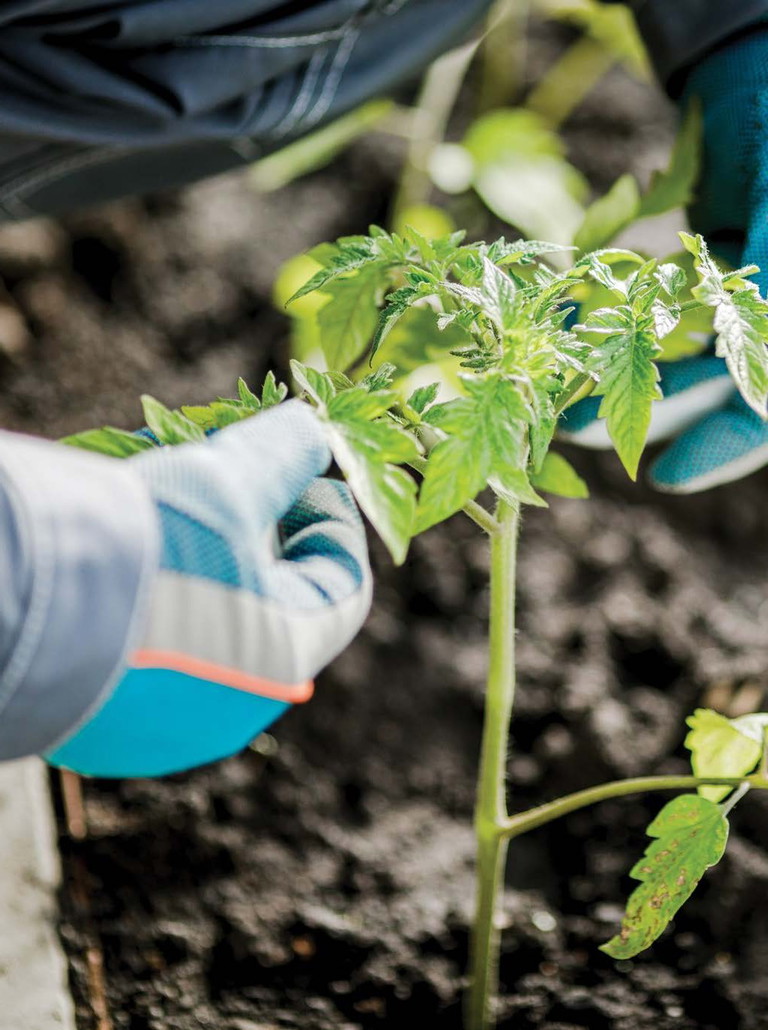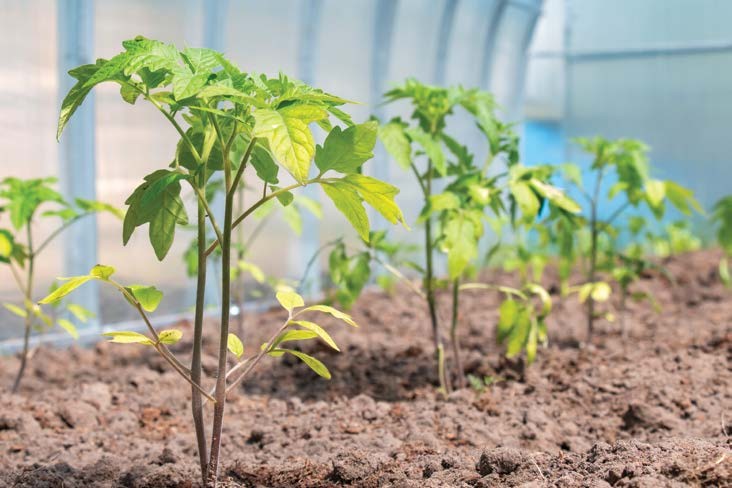UPFRONT virus update

TOMATO
BROWN RUGOSE
FRUIT VIRUS
update
Monitor crops regularly for symptoms of ToBRFV.
This article has been shared with permission — the full update including all links is available here
AUSVEG is continuing to provide updates on the national biosecurity response following the detection of tomato brown rugose fruit virus (ToBRFV) in South Australia in August. A summary of the current situation is included.
Supplied by AUSVEG

Update on Victorian detection
ON 17 January, Agriculture Victoria advised tomato brown rugose fruit virus (ToBRFV) had been detected at a tomato glasshouse facility in Victoria in seedlings recently moved from South Australia.
Agriculture Victoria has advised, as this detection is linked to a specific movement of plant material and previous surveillance has been carried out at other locations around the state, there is no evidence that ToBRFV is present in any other location in Victoria.
Quarantine controls are in place at the property and Agriculture Victoria is continuing to work with the business to ensure the virus does not spread and can be eradicated.
Further information on the Victorian detection is available here https://agriculturwe.vic.gov.au/biosecurity/plant-diseases/vegetable-diseases/tomatobrown-rugose-fruit-virus#h2-0.
National Eradication Response Plan
The National Management Group (NMG), comprising representatives of all Australian Governments and affected industry signatories to the Emergency Plant Pest Response Deed (EPPRD), issued a Communique following its meeting on 21 November to consider the eradication response to tomato brown rugose fruit virus (ToBRFV) in South Australia.
The Communique outlines that the approved ToBRFV Eradication Response Plan includes agreed measures, including ongoing testing, surveillance and monitoring, to achieve eradication and support a pathway back to the production and trade of tomatoes. The NMG has committed $5 million to achieve the response objectives. The Response Plan is being nationally cost shared by governments and industry under the EPPRD.
The latest information and resources regarding the ongoing South Australian biosecurity response is available on the state’s Department of Primary Industries and Regions (PIRSA) website https://pir.sa.gov.au.
As part of its ongoing engagement with the national response following the August detection of ToBRFV in South Australia, AUSVEG is continuing to engage with the Commonwealth to establish more details of cost sharing arrangements.
Throughout the national response AUSVEG has continued to support a biosecurity approach that mitigates the risk of spread to other farms, while facilitating the movement and supply of produce to market via evidence-based, risk-managed pathways.
AUSVEG also continues to emphasise the need for the timely progression of both the national eradication response, and communication of testing and tracing results and information to growers from relevant government agencies.
The EPPRD
Under the Government-industry partnership of the Emergency Plant Pest Response Deed (EPPRD), AUSVEG represents affected levy-paying vegetable industries covered by the EPPRD during any national biosecurity response to exotic plant pest or disease incursions, to ensure the views of the national industry are heard and acted upon.
This includes ongoing engagement with the Consultative Committee on Emergency Plant Pests (CCEPP) and the National Management Group (NMG), which are the key advisory and decision-making bodies that operate under the EPPRD.
As part of its ongoing engagement in the national response, AUSVEG has been working on behalf of the impacted levy-paying industries it represents to ensure the following principles are reflected in the Response Plan:
• That affected industries are protected from ToBRFV;
• That impacted businesses can return to trading as soon as possible;
• That the Response Plan provides the greatest possible net benefit for the national industry;
• That any financial contributions deemed necessary from levy-paying industries under the Response Plan are judicious, proportionate and equitable; and,
• That owner reimbursement costs for impacted levy-paying growers covered under the EPPRD feature in the Response Plan.
Guided by these principles, AUSVEG remains committed to working with the CCEPP and the NMG to progress the Response Plan to eradicate ToBRFV from Australia.
Role of government
State and Territory Governments are responsible for biosecurity responses within their jurisdictions, including tracing, testing and notification activities, as well as biosecurity orders including quarantine, movement and relevant border arrangements. The Federal Government is responsible for Australia’s international borders, ongoing trade discussions and coordination of the national response.
Role of industry
Under the EPPRD, affected levy-paying industry parties are represented as part of the national response to incursions of exotic priority plant pests or diseases.
While the tomato industry does not directly contribute to biosecurity levies, as the vegetable industry representative body, AUSVEG has continued to support fresh market tomato growers during the ToBRFV response. The Australian Processing Tomato Research Council and Greenlife Industry Australia are the other industry representatives involved in the national response to ToBRFV under EPPRD arrangements.
Implement strong farm hygiene measures
We continue to encourage all growers to remain vigilant and ensure all staff and visitors comply with on-site biosecurity practices, to protect their businesses from potential risks.
Biosecurity advice to growers:
• Practice “Come clean, Go clean.”, good plant hygiene
• Ensure all staff and visitors are trained and compliant with your farm biosecurity practices
• Disinfect tools, propagating material and equipment
• Wash and disinfect packaging, bins and pallets regularly
• Source seed, seedlings and graft material that is free of ToBRFV from a reliable supplier
• Maintain a seed and seedling register and record the source of farm inputs
• Test a proportion of seed and seedlings for ToBRFV
• Monitor crops regularly for symptoms of ToBRFV
• Remove volunteer or wild tomato plants and other hosts that could act as reservoirs for the virus.
Ongoing biosecurity response
The latest published information following the detection of ToBRFV at three businesses on the Northern Adelaide Plains in August is available on the South Australian Department of Primary Industries and Regions’ website at https://pir.sa.gov.au.
A summary of biosecurity controls and market access requirements in place to prevent the spread of ToBRFV into other Australian jurisdictions from South Australia is available at https://pir.sa.gov.au/biosecurity/plant health/emergency and significant plant pests/tomato brown rugose fruit virus/market access.
Information on the ToBRFV detection in Victoria in January is available at https://agriculture.vic.gov.au/biosecurity/plant-diseases/vegetable-diseases/tomatobrown-rugose-fruit-virus#h2-0.
The temporary suspension of Australian tomato imports into New Zealand remains in place, while in late December, the Department of Agriculture, Fisheries and Forestry advised the suspension of Australian tomato, capsicum and chilli imports into New Caledonia had been lifted, with new import requirements in place.
About ToBRFV
ToBRFV affects tomatoes, capsicums, and chillis, but there is no known impact on human health.
ToBRFV-infected plants show symptoms such as mosaic patterns, yellowing and deformities on leaves, while fruits develop brown wrinkled spots, deformations and uneven ripening, reducing their yield and marketability. Different plant varieties can present different symptoms.
AUSVEG has prepared a downloadable fact sheet on ToBRFV, with further information about the disease and best practice biosecurity.
Scan the QR code at the beginning of the article to access the fact sheet.
MORE INFORMATION
For further information, please contact AUSVEG National Manager – Biosecurity and Extension, Zarmeen Hassan, zarmeen.hassan@ausveg.com.au
Suspect detections should be reported to the national Exotic Plant Pest Hotline on 1800 084 881. For further information visit outbreak.org.au or pir.sa.gov.au/tobrfv
See link at QR code for updates: https://ausveg.com.au/article/tomato-brown-rugose-fruit-virus-update/